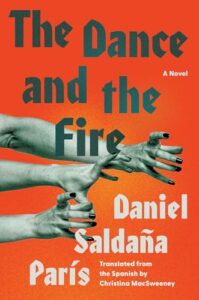If last year’s essay collection Planes Flying over a Monster was Daniel Saldaña París’ way of integrating a feeling of location into his writing, his new novel The Dance and the Fire cements it. Three old friends return to Cuernavaca, Mexico, a city engulfed in the heat of nearby fires; a symptom of climate catastrophe but also of the three friends’ mental states. While Natalia remedies herself from the strains of her marriage by choreographing an elaborate dance based off the German expressionist Mary Wigman’s style, her former fling, Erre, sleeps through the event, while Conejo, reminiscing on his time with Erre, is paralyzed by the past. The Dance and the Fire is an evocative portrait of sexuality, friendship, and art, amongst a setting of nearby destruction.
OurCulture sat down with Daniel Saldaña París to talk about location, research, and the art of dancing.

Congratulations on the new novel, your third to be translated into English! How does it feel now that it’s out?
I’m very excited about it. Every time one of my books is translated into another language, I feel grateful that I get to do this for a living; that I get to connect with readers from different cultures and traditions, perhaps even challenging some of their ideas about Latin American literature.
The Dance and the Fire follows three former high school friends that now orbit each other. When did these relationships start in your mind?
I’ve always been interested in the ways friendships change over the years, and how we remain faithful to some of those relationships even when we ourselves have changed beyond recognition. When I reached my mid-thirties, I felt the need to reconnect with some of my friends from adolescence, and catching up with them became a way of analyzing my own life in retrospect, measuring the person I am against the person I thought I would be when I first met them. This exercise can be disappointing (as in the case of Erre), but also very nourishing.
In this novel and your essay collection, Planes Flying Over a Monster, the plot is tied to the location. Is a sense of place important to you when you write?
Yes, very much so. I divide my life into distinct periods according to the cities I’ve lived in: Cuernavaca, Madrid, Mexico City, Montreal, New York. Each city has opened up a way of thinking and walking—which tend to be the same—and offered a community from which I’ve learned a lot. I try to write with that sense of belonging in mind, using place to mirror my characters’ processes.
People like Natalia appreciate it and detail it with love, but Erre doesn’t want to recognize anything. “As far as I’m concerned,” he thinks, “they can build even more shopping malls, one on top of the other… until there’s nothing left of this parody of a city, nothing besides the sound of cash registers in the clouds of smoke.” Why do you think he’s so disaffected?
Erre has a bitter experience with the city because he feels he’s returning in disgrace, having failed to meet his own expectations in the capital. But there can also be sweet returns—I’ve experienced them myself when moving back to Mexico and falling in love with the place again after a period abroad. I wanted to capture both experiences in the novel, as both are worth telling.
Which camp do you think you fall into?
I feel closer to Natalia’s way of understanding the world, but I have moments of obfuscation when I’m more like Erre, and also moments when my sensibility resembles Conejo’s. That’s what I love about writing fiction: I get to explore the different facets of myself through each character.
Natalia is so methodical and research-focused — most of her section involves scrolling through Wikipedia. Did her journey coincide with your own curiosity?
Yes, pretty much. Except that I was doing that same research at the British Library in London, thanks to a fellowship from the Eccles Centre and the Hay Festival. But the process is the same—one of curiosity and research, but also of incantation, where things seem to come together as if by magic or uncanny coincidence. That’s how I write.
You write that “the mechanisms through which a person enters the canon in this country are so unfathomable there’s no point in trying to understand them.” Do you think this is true of your own experience?
I think that assertion corresponds to an earlier period in my career. I understand those mechanisms better nowadays, but I still don’t like them.
Natalia wants her dance not to placate, but to be so bizarre that “it will be the kind where [the audience] gets angry and asks for their money back.” Why did you want her to be a sort of provocateur?
Because dance can be such a people-pleasing art sometimes, and I like it better when it’s not. Art can do many things, and I have the feeling that when it’s dominated by the free market is when it loses its edge and becomes mere entertainment. I wanted to work with a character willing to defy that notion even more than I am.
Tell me more about Mary Wigman and what interested you in her work.
I loved her idea that everybody can—and probably should—dance. That dance isn’t something reserved for trained professionals, but rather a way of engaging with the body and space that everyone can benefit from. I danced a lot while writing this book. I would go to the garden at my mom’s house in Cuernavaca, set up a camera, and improvise in front of it—then go back inside, watch the footage, and try to describe those movements in writing. I understood that, for Wigman, dance was also a way of being in conversation with one’s own shadow.
But it’s also because I’ve always been interested in that period of art history—the avant-garde movements of the early 20th century, the manifestos, the sense of openness and possibility between the wars. I came across the story of this place in the Swiss mountains where Wigman lived for a time—Mont Verità—where artists collaborated in multidisciplinary performances, learned Esperanto, and spent summers as nudists. I loved the descriptions of that brief utopia.
Conejo reflects on their time together with Erre, who at the time was still in denial about his sexuality. What did you want to explore with this?
I wanted to explore bisexuality, and the lack of language around it—at least in the 1990s, and in a small, conservative town like Cuernavaca. I am bisexual, and it took me years to even understand that that was a thing. There was simply no language, no way of naming it for me. But desire always finds its way, and it can often be through friendship, through shared silences and tenderness.
In the end, the manic dancing hysteria that the town goes through seems to resist explanation — it’s either Natalia’s dance, the fires raging via climate change, or Conejo’s conspiracy theory about the water has finally come true. Do you think it’s a combination of all three?
I’d rather not say, because it’s ultimately up to the reader. But when researching the medieval dance epidemics, my conclusion was that nobody really has a definitive explanation. Maybe it was mold in the bread—but also the social circumstances, religious pressures, hunger… I wanted to replicate that same sense of confusion.
Was it interesting to mirror all these dance crazes in the past?
It seems to me that we are in a similar place now. There’s a widespread sense of end-of-the-world anxiety, a resurgence of religious fanaticism, a climate emergency, and mental health crises emerging from all of this. I wanted to draw that parallel in the fiction.
Finally, what’s next for you as a writer?
I’m currently working on a sort of essay or memoir about an oil spill off the Galician coast in 2003. At the time, I lived in Spain, and I went to the beach to help clean the oil with a group of volunteers. In a way, I’m returning to apocalyptic landscapes and the emotional entanglements that can emerge from them—but this time as memoir. I also have a new novel coming out in Spanish this fall, called My Father’s Names. It takes place between New York City and Mexico City and follows a man trying to uncover something about his own origins. It’s more of a political novel, in a sense. I guess it will eventually come out in English, too.
The Dance and the Fire is out now.
Great Job Sam Franzini & the Team @ Our Culture Source link for sharing this story.





